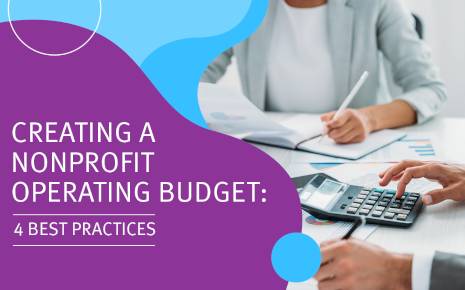Thorough financial planning is critical for nonprofits of all sizes and in all verticals. To make the greatest possible impact, you not only need to maximize your fundraising efforts but also properly allocate the funding you bring in to cover all of the costs associated with your mission and operations.
The most important financial planning tool at your organization's disposal is its annual operating budget. Jitasa's nonprofit budgeting guide defines this resource as 'a planning document used to predict expenses and allocate resources for your organization. It details both the costs that your organization will incur as well as the revenue you expect to receive over a set period of time.' In the case of an operating budget, that time period is one fiscal year.
To help you create an effective budget for your nonprofit, this guide will walk through the following four best practices:
- Set Clear, Realistic Goals
- Categorize Revenue by Source
- Allocate Expenses by Function
- Align Your Operating Budget With Your Nonprofit's Other Budgets
Budgeting requires a team effort in order to succeed. As you go through the process, ensure your board, staff, and any third-party financial professionals you work with are all on the same page about your nonprofit's situation and needs. Let's get started!
1. Set Clear, Realistic Goals
When your organization is planning a campaign or project, you probably start by taking some time to envision what you want the results to look like and set actionable goals to get there. Budgeting is no different, especially because the entire document is based on predictions. Begin the process by considering the spending and revenue generation outcomes you want to see, and use them to set goals in your budget.
Leveraging past financial data can help you make more realistic projections for the future. Base your budgeting goals on the information contained in the following resources:
- Financial statements. Most nonprofits compile an income statement, balance sheet, cash flow statement, and functional expense report each year to organize and summarize their financial data for tax filing purposes. Review last year's statements to get a sense of your organization's total revenue, expenses, and assets.
- Transaction records. To get a more detailed breakdown of specific costs incurred or contributions received, look at the transaction records that your nonprofit bookkeeper and accountant maintain.
- Fundraising campaign metrics. If you run the same types of fundraising campaigns from year to year, analyze your fundraising totals and return on investment (ROI) to set benchmarks for this year's campaign.
While some of your actual fundraising campaign goals might be 'reach' goals to push your team, it's best to write more conservative estimates in your budget. That way, you'll know to keep your predicted expenses low enough that you can still cover them if you fall short of your 'reach' goal.
2. Categorize Revenue by Source
Unlike for-profit organizations that make most of their money by selling products or services, your nonprofit likely generates revenue in multiple ways. To make the estimates in your operating budget as accurate as possible, categorize your revenue according to the following funding sources:
- Individual contributions. This category makes up the bulk of nonprofit funding and includes every small, mid-level, and major gift contributed during each of your campaigns.
- Corporate philanthropy. This includes all nonprofit contributions made by businesses, such as matching gifts, volunteer grants, and in-kind donations of products or services.
- Grants. Many government entities and foundations award grant funding to nonprofits, which can help fund your most important programs and projects.
- Investments. Nonprofit investments often take the form of endowments, but nonprofits can also open brokerage accounts and invest in stocks and cryptocurrency just like individuals can. No matter what route you take, investment interest should be categorized separately in your budget.
A common misconception about nonprofit budgeting is that because nonprofits by definition can't turn a profit, their operating budgets always have to break even. In reality, you should budget for a revenue surplus if possible. You'll have the flexibility to build a long-term savings account for your organization with your surplus funding, and you'll be in better shape to recover if a revenue source falls through or future expenses are higher than expected.
3. Allocate Expenses by Function
Another unique aspect of nonprofit budgeting has to do with expense allocation methods. Most for-profit organizations categorize costs based on the nature of payments made, such as 'production equipment purchases' or 'travel expenses.' Nonprofits organize costs based on how the payment furthers their mission, which is known as functional expense allocation.
The three categories of functional expenses to include in your operating budget are:
- Program costs. This category encompasses all expenditures that directly further your organizationâs mission, so theyâll look different for different types of nonprofits. For example, an animal shelter would include the costs of pet food and medical supplies under their program expenses.
- Administrative costs. These expenses are necessary for your organization to operate and include things like staff compensation, utility bills, insurance payments, and office equipment purchases.
- Fundraising costs. These are the upfront expenses associated with running fundraising campaigns, such as creating marketing materials or investing in specialized fundraising software.
Your administrative and fundraising costs together make up your nonprofit's overhead. You may have heard of the 65/35 'rule' of nonprofit expense allocation, which states that nonprofits should spend at least 65% of their funding on programming and no more than 35% on overhead. In reality, this breakdown will look different for every nonprofit treat the 'rule' as more of a guideline to help you reduce overhead costs and maximize program spending.
4. Align Your Operating Budget With Your Nonprofit's Other Budgets
In any given year, your operating budget likely won't be the only budget your nonprofit creates. There are several types of budgets you might reference for various activities, such as:
- Capital budgets. According to Capital Campaign Pro, budgeting is an essential step in the planning process for large-scale, long-term initiatives so you can predict your upfront campaign spending needs in the context of your goal.
- Program budgets. If you're launching a new program at your nonprofit, you might create a budget specifically to itemize your early expenses for it and outline where the funding will come from to cover those costs.
- Grant proposal budgets. Before awarding funding to your nonprofit, many grantmakers will ask to see an outline of how you plan to spend the grant money and what other funding sources you'll use to push the initiative forward.
Each of these budgets is smaller in scope than your annual operating budget, which covers all of your organization's activities. So, the revenue and expenses listed in your other budgets should line up with the overarching predictions in your operating budget. If a different type of budget overlaps multiple fiscal years, make sure your estimates are recorded in the correct annual operating budget.
_________________________________________________________________________________________________
Although you'll finalize a new operating budget at the start of each fiscal year, budgeting shouldn't be a one-and-done event. At least once a month, meet with your team to compare your budget predictions to the actual numbers in your financial records. This helps your nonprofit stay on track with spending and fundraising throughout the year and make data-driven decisions about how to proceed with your initiatives.







